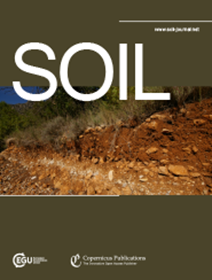Rubber plant root properties induce contrasting soil aggregate stability through cohesive force and reduced land degradation risk in southern China
IF 4.3
2区 农林科学
Q1 SOIL SCIENCE
引用次数: 0
Abstract
Abstract. In southern China, the island of Hainan faces land degradation risks due to a combination of soil physical, chemical, and climatic factors: soil physical properties like a high proportion of microaggregates (<0.25 mm), chemical properties such as low soil organic matter (SOM) content, and a climatic factor of frequent uneven rainfall. The cohesive force between soil particles, which is influenced by plant root properties and root-derived SOM, is essential for improving soil aggregate stability and mitigating land degradation. However, the mechanisms by which rubber plant root properties and root-derived SOM affect soil aggregate stability through cohesive forces in tropical regions remain unclear. This study evaluated rubber plants of different ages to assess the effects of root properties and root-derived SOM on soil aggregate stability and cohesive forces. Older rubber plants (>11 years old) showed greater root diameters (RDs) (0.81–0.91 mm), higher root length (RL) densities (1.83–2.70 cm cm−3), and increased proportions of fine (0.2–0.5 mm) and medium (0.5–1 mm) roots, leading to higher SOM due to lower lignin and higher cellulose contents. Older plants exhibited higher soil cohesion, with significant correlations among root characteristics, SOM, and cohesive force, whereas the random forest (RF) model identified aggregates (>0.25 mm), root properties, SOM, and cohesive force as the key factors influencing mean weight diameter (MWD) and geometric mean diameter (GMD). Furthermore, partial least squares path models (PLS-PM) showed that the RL density (RLD) directly influenced SOM (path coefficient 0.70) and root-free cohesive force (RFCF) (path coefficient 0.30), which subsequently affected the MWD, with additional direct RLD effects on the SOM (path coefficient 0.45) and MWD (path coefficient 0.64) in the surface soil. Cohesive force in rubber plants of different ages increased macroaggregates (>0.25 mm) and decreased microaggregates (<0.25 mm), with topsoil average MWD following the order control (CK) (0.98 mm) < 5Y_RF (1.26 mm) < mixed forest (MF; 1.31 mm) < 11Y_RF (1.36 mm) < 27Y_RF (1.48 mm) < 20Y_RF (1.51 mm). Rubber plant root traits enhance soil aggregate stability and mitigate land degradation risk in tropical regions, offering practical soil restoration strategies through targeted root trait selection to strengthen soil cohesion, ensure long-term agricultural productivity, and preserve environmental quality, highlighting the need for further research across diverse ecological zones and forest types.橡胶植物根系特性通过黏结力诱导土壤团聚体稳定性,降低土地退化风险
摘要。在中国南方,由于土壤物理、化学和气候因素的综合作用,海南岛面临着土地退化的风险:土壤的物理性质,如高比例的微团聚体(11年)表现出更大的根直径(0.81-0.91 mm),更高的根长(RL)密度(1.83-2.70 cm cm−3),细根(0.2-0.5 mm)和中根(0.5-1 mm)的比例增加,由于木质素和纤维素含量的降低,导致SOM升高。年龄较大的植物表现出较高的土壤黏结力,根系特征、SOM和黏结力之间存在显著的相关性,而随机森林(RF)模型认为团聚体(>0.25 mm)、根系特征、SOM和黏结力是影响平均重径(MWD)和几何平均直径(GMD)的关键因素。此外,偏最小二乘路径模型(PLS-PM)表明,RLD直接影响表层土壤的SOM(路径系数0.70)和无根黏结力(路径系数0.30),进而影响MWD, RLD还直接影响表层土壤的SOM(路径系数0.45)和MWD(路径系数0.64)。不同年龄橡胶树的黏结力增大了大团聚体(> ~ 0.25 mm),减小了微团聚体(<0.25 mm),表层土壤平均MWD服从顺序控制(CK) (0.98 mm) < 5Y_RF (1.26 mm) <混交林(MF);1.31毫米)< 11 y_rf(1.36毫米)< 27 y_rf(1.48毫米)< 20 y_rf(1.51毫米)。橡胶植物根系性状提高了热带地区土壤团聚体稳定性,减轻了土地退化风险,通过有针对性的根系性状选择提供了切实可行的土壤修复策略,以增强土壤凝聚力,确保长期农业生产力,保护环境质量,突出了对不同生态区和森林类型的进一步研究的必要性。
本文章由计算机程序翻译,如有差异,请以英文原文为准。
求助全文
约1分钟内获得全文
求助全文
来源期刊

Soil
Agricultural and Biological Sciences-Soil Science
CiteScore
10.80
自引率
2.90%
发文量
44
审稿时长
30 weeks
期刊介绍:
SOIL is an international scientific journal dedicated to the publication and discussion of high-quality research in the field of soil system sciences.
SOIL is at the interface between the atmosphere, lithosphere, hydrosphere, and biosphere. SOIL publishes scientific research that contributes to understanding the soil system and its interaction with humans and the entire Earth system. The scope of the journal includes all topics that fall within the study of soil science as a discipline, with an emphasis on studies that integrate soil science with other sciences (hydrology, agronomy, socio-economics, health sciences, atmospheric sciences, etc.).
 求助内容:
求助内容: 应助结果提醒方式:
应助结果提醒方式:


